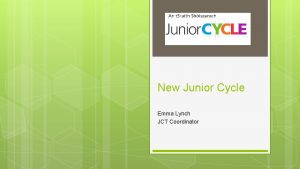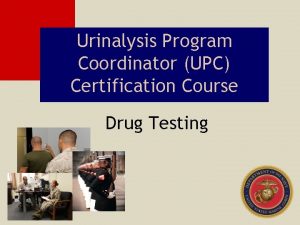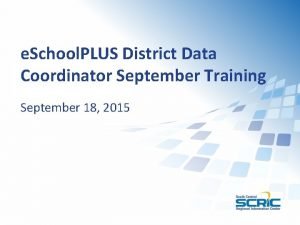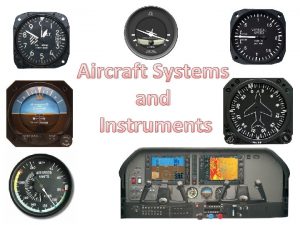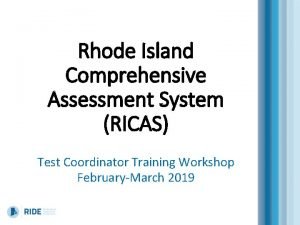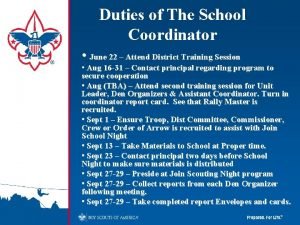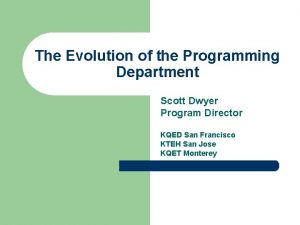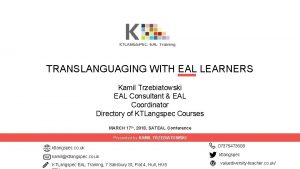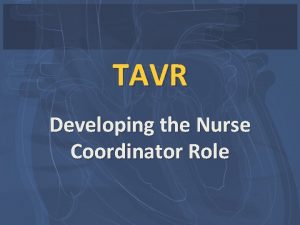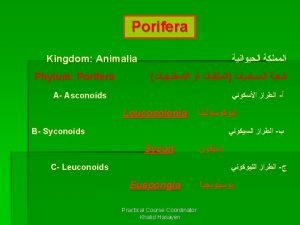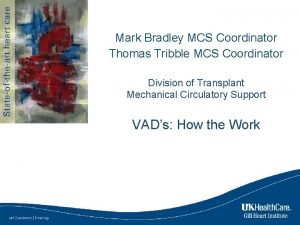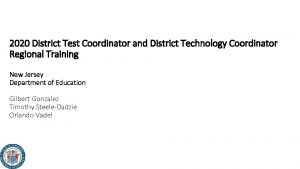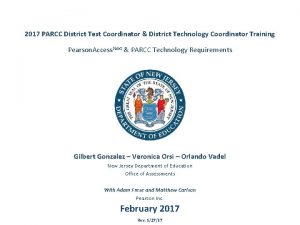Developing the Role of the EAL Coordinator EAL














- Slides: 14

Developing the Role of the EAL Coordinator EAL Workshop 28 th February 2019 King George’s Conference Centre Stockwell

Session Agenda 09. 15 am Welcome and Introduction Feyisa Demie, Head of Research and Statistics and Adviser for School Self-evalution 09. 25 am Developing the Role of the EAL Coordinator – Workshop Amanda Bellsham-Revell, EAL Consultant • Leadership and Management • Assessment of Stage of English Proficiency 10. 30 am Break 10. 40 am (cont. ) • • 12. 15 pm Learning and Teaching Children new to English and resources Curriculum Partnership with parents End of Session

Assessing English Proficiency Dr Feyisa Demie

Why EAL Matters EAL Population in State-funded Schools in England 1997 -2018 1600000 1557511 1400000 1306829 1247715 1184727 1200000 1122080 1059880 Pupil No. • EAL population in England is growing. • EAL has seen a dramatic rise, from 500, 000 in 1997 to 1. 5 million in 2018. This is about 20% of all pupils in England (About 50% of Lambeth pupils). • Over 350 different languages spoken in England’s schools (141 languages in Lambeth) • Accordingly, levels of pupils who are not proficient in English has also increased 1006085 956605 1000000 798110 800000 632718 600000 505200 542167 546484 566768 657297 686200 702190 832790 865590 905620 742590 590405 400000 200000 0 1997 1998 1999 2000 2001 2002 2003 2004 2005 2006 2007 2008 2009 2010 2011 2012 2013 2014 2015 2016 2017 2018

What does the data tell us about EAL English Proficiency?

English Proficiency in Lambeth Schools 2018 Primary Schools Secondary Schools 50, 0% 45, 0% 40, 0% 35, 0% 27, 7% 30, 0% 25, 0% 20, 0% 15, 0% 30, 0% 18, 8% 20, 0% 15, 2% 15, 0% 10, 8% 10, 0% 5, 0% 0, 0% A 26, 9% 25, 0% 22, 7% 20, 0% 48, 9% B C D Stage of English Proficiency E 6, 8% 2, 2% A B C D Stage of English Proficiency E

How long does it take to acquire English proficiency for EAL pupils? Length of time needed by languages spoken Number of years at each stages of fluency in English Total Years in Stage 1 – 3 Stage 1 Beginners and New to English Stage 2 Becoming familiar with English Stage 3 Becoming confident as user of English Turkish 1. 8 3. 0 2. 8 7. 6 25 Lingala 1. 9 2. 8 7. 5 14 Spanish 1. 5 2. 6 2. 7 6. 8 91 Bengali 1. 6 2. 3 2. 8 6. 7 65 Portuguese 1. 6 2. 2 2. 6 6. 4 265 Chinese 1. 4 2. 2 2. 8 6. 4 36 Twi-Fante 1. 4 1. 5 3. 0 5. 9 42 French 1. 5 2. 8 52 Yoruba 1. 5 1. 8 2. 3 5. 6 38 Somali 1. 5 1. 9 2. 1 5. 6 93 Polish 1. 4 1. 8 4. 6 22 Average 1. 5 2. 1 2. 6 6. 2 940 Languages spoken by Year 6 -11 EAL students in 2011 Number of speakers

EAL/non-EAL Gap by Key Stage (2018) • Performance gap between EAL and non-EAL pupils varies between key stages. • Biggest performance gap is at EYFS. • By Key stage 1 and 2, the gap has narrowed but remains larger in Reading. EAL pupils beginning to excel at Maths. • By GCSE, the gap has completely closed and EAL pupils perform significantly better than their monolingual English speaking peers. Gap -7% EAL 66% National Non-EAL 74% 80% 75% 80% 71% -3% -1% -2% 73% 69% 75% 64% 77% 71% 77% 66% -4% -2% -2% 75% 81% 82% 68% 82% 84% 80% 85% 72% -7% -3% +1% -3% -4% 70% 77% 79% 63% 77% 79% 75% 77% 65% -7% -2% +2% -2% 47. 0 +0. 32 58% 36% 42. 2 -0. 43 50% +6% +4. 8 +0. 75 +8% 44% 47. 9 +0. 49 43% 46. 3 -0. 10 +1% +1. 6 +0. 59 Stage EYFSP Measure Overall (GLD) EAL 69% KS 1 Reading Writing Maths Overall (RWM) 77% 74% 79% 69% KS 2 Reading Writing Maths GPS Overall (RWM) GCSE 9 -5 EM Attainment 8 Progress 8 5+ A*-C inc EM Lambeth non-EAL 76% Gap -8%

KS 2 by Stage of English Proficiency • Nearly all pupils in the early stages of English proficiency did not achieve the expected standard. No Stage A pupils achieved RWM • Pupils at early stages of proficiency performed better at Maths than at Reading or Writing. • Not until Stage E do EAL pupils outperform English Only pupils. Stage D pupils were performing below their monolingual peers. • The achievement of fully fluent in English pupils continues to be high, 17 percentage points above the overall test average for all pupils. Proficiency Reading Writing Maths RWM GDS Stage A 0% 3% 9% 0% 0% Stage B 24% 20% 46% 12% 1% Stage C 65% 76% 80% 56% 2% Stage D 77% 85% 83% 67% 8% Stage E 89% 95% 86% 15% English Only 82% 81% 72% 14% Lambeth 77% 82% 69% 11%

GCSE by Stage of English Proficiency • EAL indicator does not tell the full story. Achievement varies considerably when examining pupil’s stage of English proficiency. • Pupils in the early stages of English proficiency did not achieve any of the headline measures. No Stage A pupils achieved 9 -5 English and Maths. • As stage of proficiency in English improves, so does performance. • Stage C pupils are still underperforming when compared to English-only peers. • By Stage D and Stage E, EAL pupils are outperforming English Only pupils by a considerable margin • Stage E (fully fluent) pupils achieve several percentage points above the national average for all pupils. Proficiency 9 -5 5+A*-C/9 -4 Attainment English and 8 Maths Stage A 0% 18. 7 0% Stage B 3% 26. 5 10% Stage C 22% 40. 0 39% Stage D 48% 49. 6 68% Stage E 47% 49. 4 65% English Only 34% 41. 2 49% Lambeth 39% 44. 4 55% National 43% 46. 4

Secondary: Case Study School 1 - EAL GCSE Attainment by Stage of English Proficiency • The GCSE attainment data using EAL proficiency stages shows that no-one at early stages of proficiency in English achieved any outcomes with no stage B (Early Acquisition) or Stage C pupils achieving the 4 -9 English and Maths measure in this school. By Stage D (competent) this had increased to 35% and by stage E (fully fluent), 62% of pupils were achieving the 4 -9 measure and 37% the higher 5 -9 measure. • Overall the results of the GCSE analysis show that outcomes for pupils improved as proficiency in English increased. EAL Stages Stage A (New to English) No of % of 4 -9 EM children Attainment 5 -9 EM Att 8 0 0 - - - 1 1 0% 0% 34. 5 2 3 0% 0% 31. 1 Stage D (Competent) 23 29 35% 13% 34. 5 Stage E (Fully Fluent) 52 67 62% 37% 47. 2 All- EAL 78 100 51% 28% 42. 9 Stage B (Early Acquisition) Stage C (Developing Competency)

Primary: Case Study School 2 - EAL KS 2 attainment by stage of English Proficiency • The KS 2 attainment data using EAL proficiency stages also shows that only one pupil at stage B (Early Acquisition) achieved the expected standard of achievement in Reading and writing. EAL pupils at lower levels of proficiency achieved better at Maths with 85% in Stage C achieving the measure but only 54% achieving at Reading and writing. All stage E (fully fluent) pupils achieved the expected standard at all measures. • Overall the results of the KS 2 analysis show that the percentage of pupils attaining expected outcomes in each subject at the end of primary education increases as the stage of proficiency in English increases. % at ARE EAL Stages % of No of pupils Reading Writing pupils Maths RWM Stage A (New to English) 0 0% - - Stage B (Early Acquisition) 6 4% 17% 33% 0% Stage C (Developing Competency) 13 16% 54% 85% 46% Stage D (Competent) 18 24% 94% 100% 89% 83% Stage E (Fully Fluent) 4 52% 100% All- EAL 41 100% 71% 73% 80% 61%

Primary: Case Study School 3 - EAL KS 2 attainment by stage of English Proficiency • The KS 2 attainment data using EAL proficiency stages shows that no-one at stage A (New to English) or stage B (Early Acquisition) achieved the expected standard of achievement in Reading, Writing or Maths. By stage C, 50% of pupils achieved the RWM combined measure. All stage E (fully fluent) pupils achieved the expected standard at all measures. • Overall the results of the KS 2 analysis show that the percentage of pupils attaining expected outcomes in each subject at the end of primary education increases as the stage of proficiency in English increases. • Since there is a clear relationship between proficiency in English and attainment, it is important to use this information as a diagnostic tool to track progress. It is important therefore, we continues to collect information on EAL proficiency. % at ARE EAL Stages Stage A % of No of pupils Reading Writing pupils Maths RWM 1 4% 0% 0% Stage B 1 4% 0% 0% Stage C 4 16% 50% 75% 50% Stage D 6 24% 67% 100% 67% 50% 13 52% 100% 25 100% 76% 88% 80% 72% Stage E All- EAL

Conclusions and implications for policy and practice • EAL pupils overall do not perform as well as their non-EAL peers in English schooling because of English language barriers. • In particular EAL pupils not fluent in English achieve significantly below the national average compared to monolingual English speakers in English schools. • There is a wide variations in performance and in the achievement gap between EAL not fluent in English and monolingual pupils. • EAL pupils in the early stages of English proficiency, performed at low levels, while the achievement of EAL pupils who were fully fluent in English far outstripped that of pupils for whom English was their only language. • Overall the findings of the research confirm that there is a strong relationship between stage of proficiency
 Problem management definition
Problem management definition Jct sphe
Jct sphe Role conflict occurs when fulfilling the role expectations
Role conflict occurs when fulfilling the role expectations Azure web role worker role example
Azure web role worker role example Krappmann schaubild
Krappmann schaubild Usmc upc
Usmc upc District data coordinator
District data coordinator West lafayette campus title ix coordinator
West lafayette campus title ix coordinator C172 vacuum system
C172 vacuum system Compilation of work in work immersion
Compilation of work in work immersion Total army sponsorship program
Total army sponsorship program Ricas pearson
Ricas pearson School wins coordinator duties and responsibilities
School wins coordinator duties and responsibilities Kteh schedule
Kteh schedule Lcif full form
Lcif full form

